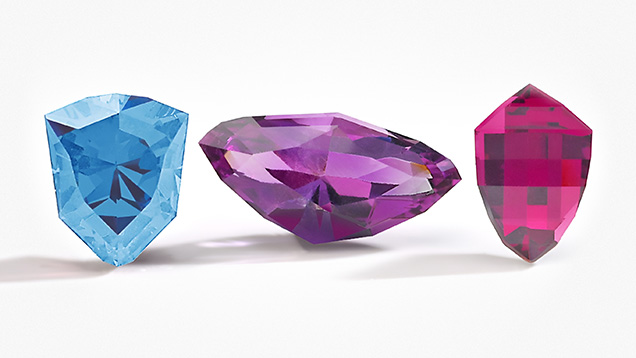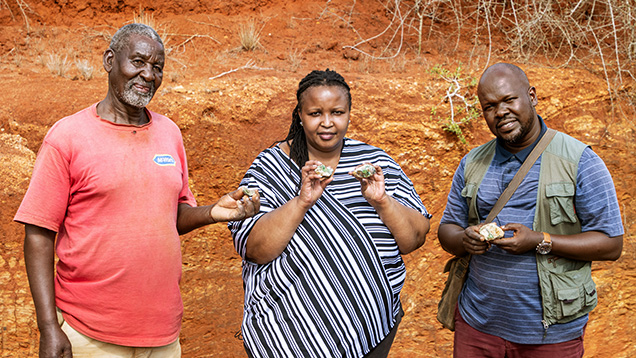More on Virtu Gem’s Ethical Supply Chain Practices

We first covered Virtu Gem at the 2023 Ethical Gem Fair in Tucson (see Spring 2023 GNI, pp. 122–125). Virtu Gem gives artisanal and small-scale miners, traders, and cutters in Kenya, Malawi, and Zambia formal access to the international market and offers training in cutting, basic gemology, and mine safety.
The gems Virtu Gem sells (see figure 1) are cut in the source country and tracked with Provenance Proof Blockchain. One of Virtu Gem’s efforts is training artisans in cutting and polishing standards to meet international market expectations. Percy Maleta, Virtu Gem’s country exporter and ambassador in Malawi, said the training has attracted many cutters there and allowed them to sell gems at premium prices.

In 2022, Virtu Gem launched the National Gem Cut Course in the three countries. In online workshops led by Adriano Mol from the University of Minas Gerais State, cutters learned facet development and brainstormed to design gem cuts to represent their nations. The resulting cuts (figure 2) resembled a cheetah head for Kenya, the mbuna (cichlid) fish for Malawi, and the eagle for Zambia. Buyers can order gemstones from each country in its respective cut.
Virtu Gem has received two grants from the World Bank as well as assistance from other organizations. Rio Grande donated a GemLightbox, and Virtu Gem purchased more for its three country coordinators. The GemLightboxes allow traders to upload photos and videos of gems to the online sales platform rather than export stones on consignment. In addition, Gemworld donated its World of Color books to each country coordinator, which help traders evaluate color and cut and set prices.
The donations have also been instrumental in Virtu Gem’s work with the National Gem Cutting School in Zambia, where students use the books and GemLightboxes. Virtu Gem cofounder Susan Wheeler said there are many gem cutters in Kenya, and she would like to establish a gem cutting program for women in Malawi.
Wheeler said gemology students should understand the ethical issues inherent in the traditional gemstone supply chain and the importance of cutting in the source country. She emphasized the importance of knowing that prices are based on not only the gemstones but also the labor of the miner and the jewelry manufacturer and other costs.

Virtu Gem’s country coordinator for Kenya, Caroline Muchira (figure 3), is a gem cutter by trade. While working full-time in logistics, she was inspired to travel more than 300 km by bus every weekend from Nairobi to Voi to visit the mines and talk to traders. “I was fascinated by the gemstones and how the miners could tell the difference between green garnet, green tourmaline, and pieces of green glass,” Muchira said. She planned to study gemology in retirement, but in 2009, after the company she worked for was sold, she sold all of her belongings to earn her Graduate Gemologist diploma at GIA’s Thailand school. During Muchira’s visits to Voi, she saw the issues the miners faced, especially women and youth. “Often they are unable to sell their stones at a fair price to middlemen, whose aim is to strike the lowest possible deal, leaving miners barely able to eke out a living,” she said. Virtu Gem’s system focuses on fair pricing, and Muchira now runs the organization’s pricing workshops.
Muchira’s ability to earn a GG is not the norm. Maleta said many in Malawi’s gem trade are interested in taking GIA courses but can’t afford it. “In a country with more than 60,000 artisanal and small-scale miners, Malawi probably only has two or three GIA graduates,” he said.
The communities Virtu Gem works with produce a wide variety of gemstones, but they have yet to access some resources. While some artisanal and small-scale mining (ASM) of emeralds occurs in Zambia, Wheeler pointed out, the miners are largely unable to access the more than 400 ASM emerald concessions in Zambia, in the same area as Gemfields. Two women they work with in Zambia have a digger but can’t afford the fuel to run it. “They could be producing the same quality emerald as Gemfields,” Wheeler said. “They can’t afford to do it on a regular basis, and loans are very expensive. We want to support the emerald mining. So we’re trying to work on how to go forward with sourcing and getting more supply with emeralds.”
Virtu Gem is part of the United Nations Conscious Fashion and Lifestyle Network, which highlights collaborations that further the UN’s Sustainable Development Goals (SDGs). Virtu Gem’s efforts are associated with six of the SDGs: ending poverty, ending hunger, gender equality, decent work, inclusive and sustainable industrialization, and reducing inequality. “We’re going to continue to align everything that we do in Virtu Gem with the Sustainable Development Goals so people can see that framework and what gemstones can do to make progress,” Wheeler said.


